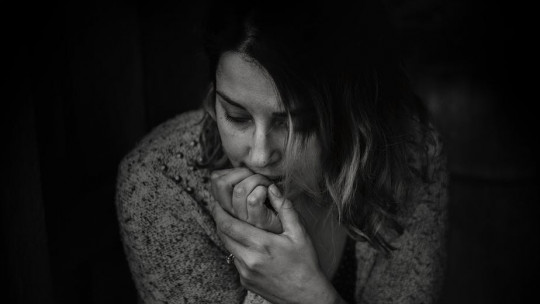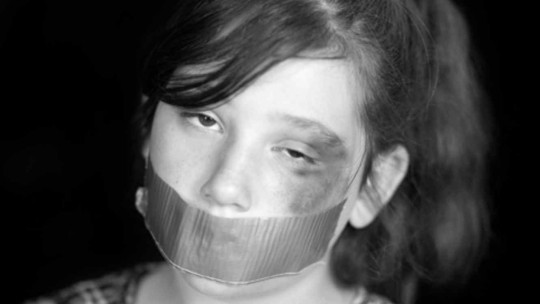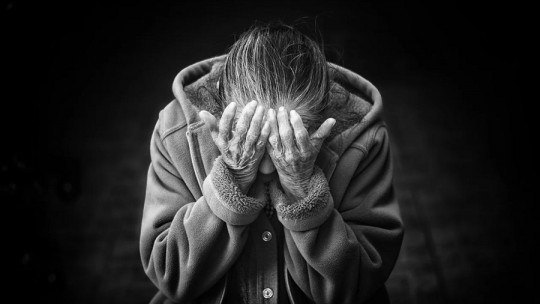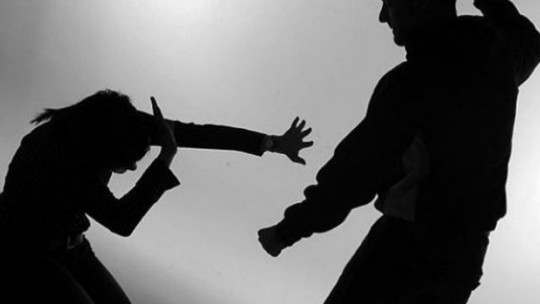
Violence has been part of human history. This phenomenon is as old as the first human instinct to dominate, to survive. At the moment, An attempt has been made to conceptualize and problematize it due to the various conditions derived from it In recent centuries, humanity has been violated on unprecedented scales. The emergence of different ideologies of hate has stained the chronology of human beings with blood, however there is still more behind this dark panorama.
Marital violence: definition and context
The specter of violence is more tangible every day. It crawls through the streets, spreads through the media, bubbles up in workplaces, schools and homes. The number of investigations in this regard, carried out by psychology professionals and experts on the subject, has increased in recent decades due to the need to generate new knowledge of both its causes and its consequences. It is evident that it is no longer enough to reflect on the problem; we must create psychological and social theories that allow us to prevent and correct this evil that afflicts the entire society. For this, a greater understanding of reality, today so complex, must be achieved, directing efforts towards pertinent actions that not only prevent, but also give rise to a reformulation of social paradigms around violence.
A study titled “Unmasking marital violence: relationship between coping with stress and the prolongation or termination of a devastating affair,” analyzed violence and its types according to the categorization established by the World Health Organization (WHO) in the private sphere and addressed 3 variants of violence: family violence, partner or marital violence and gender violence, focusing mainly on marital violence.
According to the WHO (2014), Systematic abuse between two or more family members is called family or intrafamily violence ; Marital violence refers to the behavior of the partner or ex-partner that causes physical, sexual or psychological harm and gender violence is that which emphasizes violence against women because they belong to the female sex, although some differ from the latter. specialists and which will be detailed later.
The consequences of marital violence
Now, what are the repercussions of acts of violence on the study subjects? Violence, in all its expressions (psychological, physical, economic, patrimonial, sexual and symbolic), carries observable consequences both in the social and individual aspects.
At the individual level manifest physically and psychologically The individual level in turn has serious repercussions on the social aspect; where serious problems are found in education, the economy and politics. Both individually and socially speaking, violence directly affects the quality of life. Psychologically speaking, quality of life is modulated by different factors such as: anxiety, depression, expectations towards treatment, social support and stress in its different modalities.
The word stress has become so common nowadays that its true effect has been neglected. According to the American Psychological Association (APA), stress is defined by Baum as “…(any) annoying emotional experience that is accompanied by predictable biochemical, physiological and behavioral changes.” When faced with a stressful situation, individuals tend to resort to certain actions that allow them to regain control of the situation and reduce the level of stress; This is known as coping.
He coping It is, then, any resource used by the affected person to cope with or cope with the stressful event; These resources can be cognitive or behavioral. Coping resources are made up of thoughts, attitudes, omissions, reinterpretations, behaviors, etc., the individual in question can develop or adopt different types of coping, it is also necessary to mention that not all people react in the same way to certain situations.
The appearance of stress in marital violence: a study
The studies that allow us to know about coping with stress in both men and women who suffer from marital violence are limited. Studying coping and its styles will allow us to decipher other methods that serve as prevention or guidance to deal with marital violence. That’s why, The purpose of the aforementioned study was to identify the frequency of stress coping styles and strategies used by men and women victims of marital violence ; as well as the relationship that exists between these and the permanence or termination of the relationship.
Among the nameless voices and the invisible ones that are still present, there were 5 subjects who constituted the case studies; 3 female and 2 male. Initially, there were more subjects who had already provided their approval to be interviewed, however when faced with the questions in the questionnaires they chose to abstain from participating. There were some who, although they preferred not to participate, asked for a little time simply to tell their story, which were not included in the study because the other instruments had not been completed.
Qualifying: women and men can suffer marital violence
It is also necessary to point out that although statistically women are the ones who mostly suffer from violence in all areas, for this study men were also included due to the importance this represents for the search for greater gender equality in society. This is because one cannot speak of gender equality when attention is paid to one of the two sexes, leaving violence against men invisible only due to their masculine condition. Marital violence, whether it occurs from man to woman, from woman to man, from man to man or woman to woman, is reprehensible and cannot have a place within society.
The study subjects were selected based on availability in terms of sex, orientation, age and education. As for age, they were in a range of between 25 and 55 years. All of them are actively working and their educational levels range from high school to postgraduate. The above allowed the research to highlight the fact that there is a diversity of factors that influence marital violence, including social and cultural factors.
It is also important to comment that when talking about violence, the mind tends to invoke or visualize it graphically with broken lips and violet eyelids, however, in accordance not only with the results of this research but also based on the results published by the INEGI In ENDIREH 2011, of the four types of violence, the most representative is emotional or psychological violence due to its high incidence rates. It is due to the everyday nature with which psychological violence occurs, which has become naturalized, minimizing at the same time the risks it entails, which were mentioned above and which allow progress between the different phases of violence.
The results
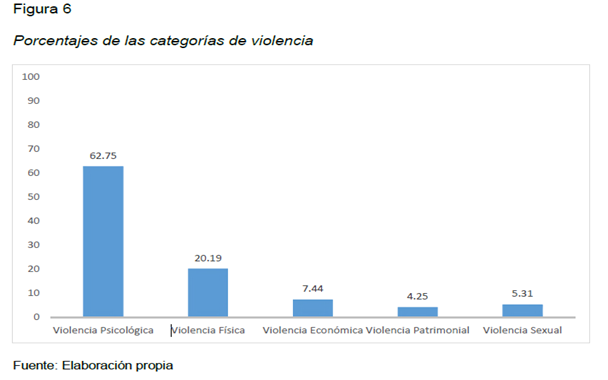
Within the ENDIREH questionnaire used for the interview, a section was found called opinion on gender roles, which mainly refers to the most common stereotypes related to the female and male sex. In the results of this section, 100% of those interviewed concluded that they disagreed that the woman should obey everything she is ordered, that the man should bear all the responsibility for household expenses and in which it is a woman’s obligation to have sexual relations with her partner. Also, 100% of the subjects agreed that childcare should be shared as a couple and that women’s ability to work and earn money. This allows us to see that absolutely all of the interviewees sought a politically correct answer, avoiding providing an answer that was in line with their true opinion or reality. In this case, it is recommended that ENDIREH rethink the questions in this section. For the purposes of this research, it was not necessary to develop another instrument to replace this section because these data were considered secondary and were not taken into consideration for the validation or refutation of the premises of the research since gender stereotypes They are not part of the objects of study.
Another important but alarming fact was found during the interview when the study subjects expressed their dissatisfaction regarding the care obtained at the time they requested help from the corresponding authorities and family members. Both men and women reported that when they requested support, it was denied or the process was extremely long.
In relation to coping strategies and styles, both sexes had almost similar proportions in terms of self-blame strategies, with only.2 points difference between their means. The above means that Both men and women present a similar tendency when it comes to blaming themselves for acts of violence carried out against them These types of strategies are very dangerous since to a certain extent they justify marital violence by allowing the victim to stoically endure the abuse. At the other extreme are the acceptance and ventilation strategies, which have a difference of 3.4 and 3 points, respectively, with men being the ones who used these types of resources more.
Some conclusions
Summarizing, from the results obtained, it can be concluded that the subjects, men and women, who are victims of marital violence usually use both coping styles focused on the problem and those focused on emotion, however, there is a difference in the frequency of the strategies used between men and women, observing a greater recurrence of styles focused on the problem on the part of women as well as a greater incidence on styles focused on emotion on the part of men. The above means that women are more likely to actively confront marital violence, seeking to eliminate or reduce the effects of violence and the violence itself; while the man deals with it in an inactive way and with strategies more oriented towards the emotional and his interpretation of the problem.
The fact that men had a greater recurrence of using coping styles focused on the problem suggests that the mediatization of stereotypes and the role of men lead them to deal with stress passively, compared to women, where it is less accepted every day. abuse by your partner.
Regarding the results obtained on the coping styles used by the study subjects, it was observed that Those individuals who decide to remain in a violent relationship have a greater repertoire of strategies that allow them to cope with the problem, compared to those who decided to end the relationship. It was also shown that of the subjects studied, those who used more resources within the problem coping style were more likely to end their relationship, as can be seen in the following table.
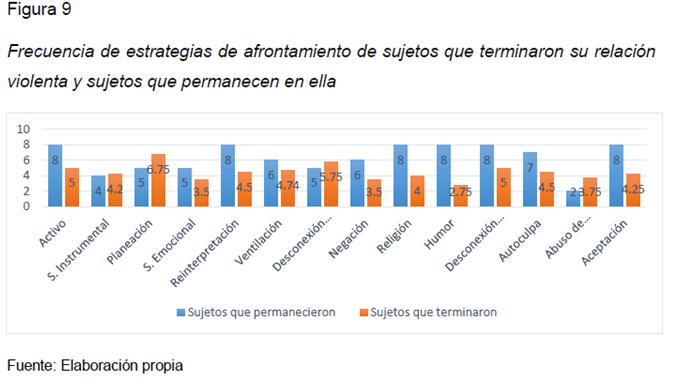
According to Díaz-Aguado, psychology has the power and duty to act as a substantial agent in the fight against violence. One of the essential factors is its representation, that is, “the representation that a person or a people has of violence and its possible victims, plays a decisive role in the risk of exercising it” (Díaz-Aguado, 1999 , p.415). That is why through this study we sought to show that marital violence is not inevitable. Revealing the multiple faces of marital violence as well as the coping styles and strategies used by victims is an attempt to reconfigure the current representation of intimate partner violence. For now, all that can be said is that the path against violence is long and narrow, but each step taken is not a step in vain.


